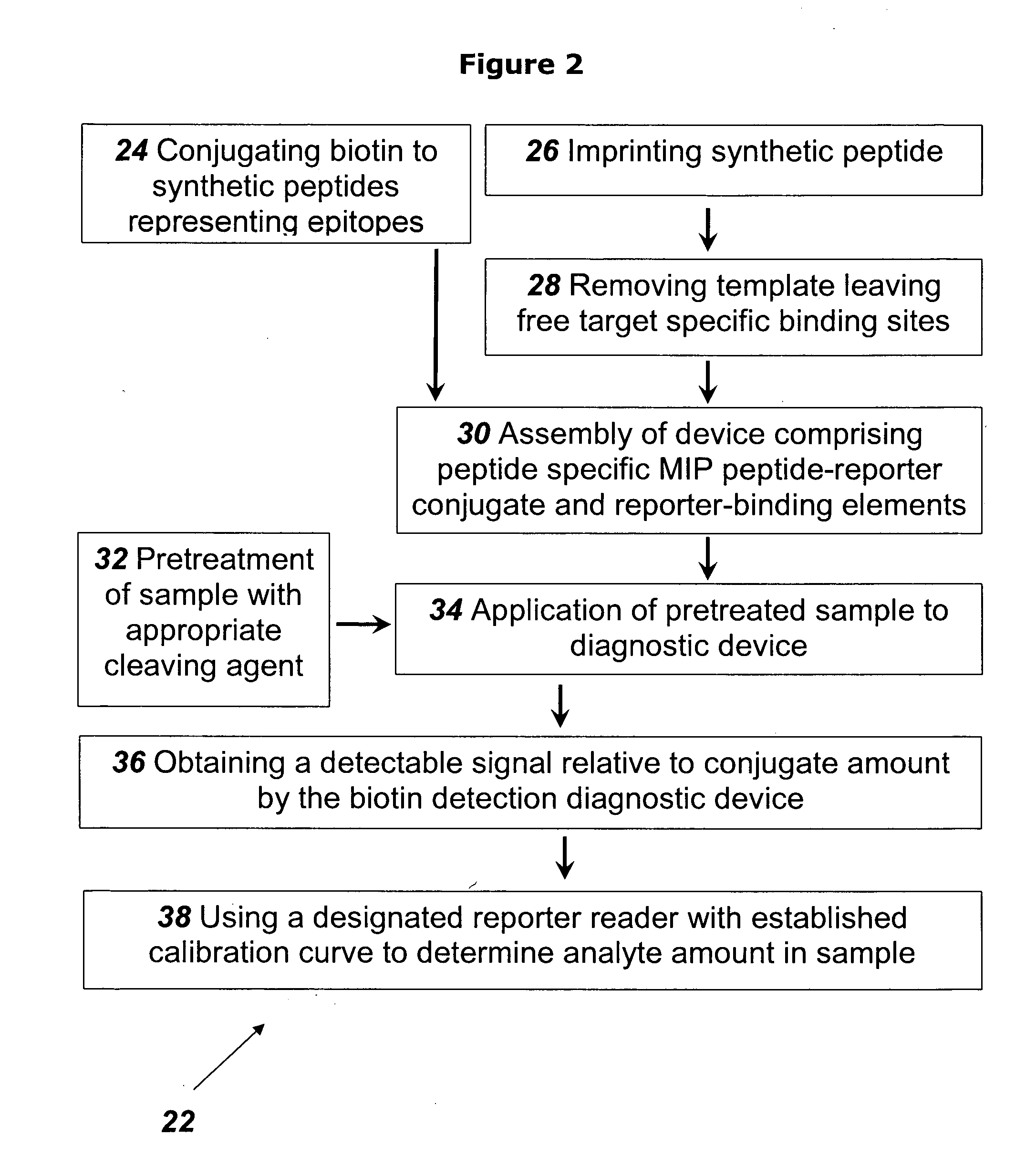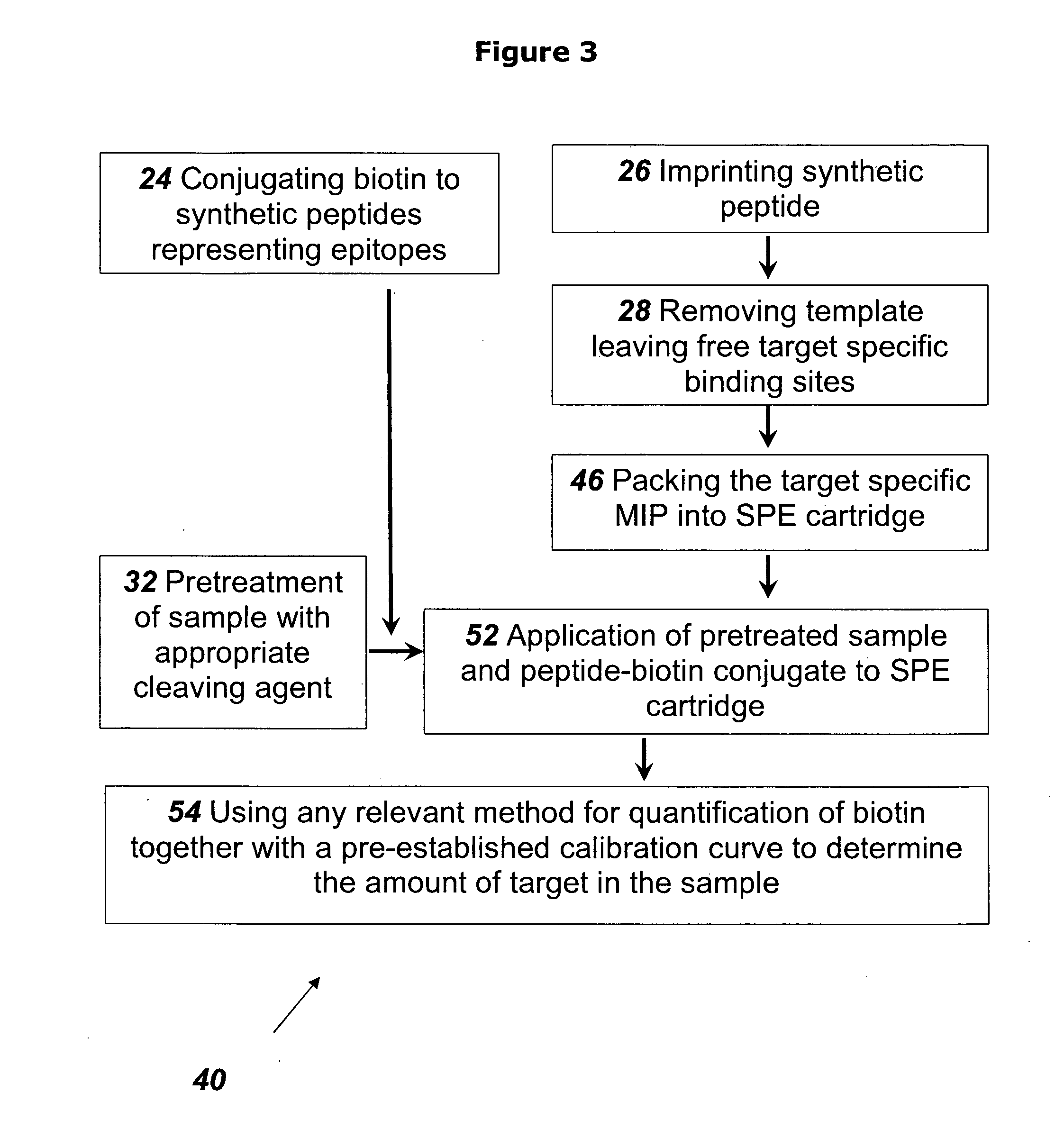Method for preparing protein imprinted polymers and use thereof
- Summary
- Abstract
- Description
- Claims
- Application Information
AI Technical Summary
Benefits of technology
Problems solved by technology
Method used
Image
Examples
example 1
[0111]This example describes the identification of an epitope on the NT-proBNP protein that is suitable for us as a template for a NT-proBNP specific MIP, and the preparation of a synthetic peptide representing this epitope, as well as a biotin-peptide conjugate.
[0112]The sequence of the NT-proBNP, as obtained from the web site of the National Center for Biotechnology Information (NCBI) is as follows:
10 20 30 40 HPLGSPGSAS DLETSGLQEQ RNHLQGKLSE LQVEQTSLEP 50 60 70LQESPRPTGV WKSREVATEG IRGHRKMVLY TLRAPRS
[0113]The on-line program “PEPTIDE CUTTER” was used to obtain the cleavage map of the NT-proBNP. This is a web based program that searches a protein sequence from the SWISS-PROT and / or TrEMBL databases or a user-entered protein sequence for protease cleavage sites. Single proteases and chemicals, a selection or the whole list of proteases and chemicals can be used. Different forms of output of the results are available: Tables of...
example 2
[0115]This example describes the preparation of NT-proBNP specific MIP.
[0116]Preparation was in accordance with the methods set forth in the review by Yan and Row (Int. J. Mol. Sci. 2006, 7, 155-178) as follows. The functional monomer, methacrylic acid (MAA) (Cat. No. 155721, Aldrich) was mixed with the target print molecule, in this case the synthetic peptide described in Example 1 above, together with the cross-linking monomer ethylene glycol dimethacrylate (EGDMA), (Cat. No. 33568-1, Aldrich), in 3% water in acetonitrile (Cat. No. 360457,Sigma-Aldrich), together with the initiator 2,2′-azobis(2,4-dimethylvaleronitrile) (Cat. No. 002094, Chemos GmBH, Germany). The mixture was degassed and purged with nitrogen for 5 min and the polymerization took place for 16 hours at 40° C., resulting in a rigid insoluble polymer with NT-proBNP -specific binding cavities present within the polymeric network. The bulk polymer was ground and wet sieved in ethanol through 63 and 25 μm sieves. The fr...
example 3
[0117]This example describes the use of the NT-proBNP-specific MIP of Example 2 in the detection of NT-proBNP in a sample, using a rapid lateral flow and / or flow through MIP based device as disclosed in patent application No. PCT / IL2008 / 001688. The device is assembled using the NT-proBNP specific MIP as the detection element.
[0118]The sample containing the NT-proBNP is digested with Chymotrypsin under conditions that ensure full cleavage of the proteins in the sample. One unit of enzyme hydrolyzes 1.0 μmole of the target protein per minute at pH 7.8 at 25° C. The time needed for full cleavage is calculated according to the amount of target protein and the amount of enzyme in the reaction mixture.
[0119]Upon the treatment of the sample with Chymotrypsin, all the proteins in the sample are cleaved according to their respective cleavage sites, producing fragments which include the peptide corresponding to the epitope peptide that was used to prepare the NT-proBNP specific MIP, in an amo...
PUM
| Property | Measurement | Unit |
|---|---|---|
| Concentration | aaaaa | aaaaa |
| Electrical resistance | aaaaa | aaaaa |
| Capacitance | aaaaa | aaaaa |
Abstract
Description
Claims
Application Information
 Login to View More
Login to View More - R&D
- Intellectual Property
- Life Sciences
- Materials
- Tech Scout
- Unparalleled Data Quality
- Higher Quality Content
- 60% Fewer Hallucinations
Browse by: Latest US Patents, China's latest patents, Technical Efficacy Thesaurus, Application Domain, Technology Topic, Popular Technical Reports.
© 2025 PatSnap. All rights reserved.Legal|Privacy policy|Modern Slavery Act Transparency Statement|Sitemap|About US| Contact US: help@patsnap.com



